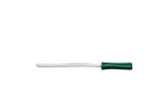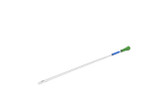What Are Intermittent Catheters?
Intermittent catheters are thin, flexible tubes designed to help individuals empty their bladder when they cannot do so naturally. These single-use devices are inserted through the urethra, directed to the bladder, and removed after use. Intermittent catheterization offers a safe and effective solution for managing urinary incontinence, retention, or complications related to spinal cord injuries and prostate conditions.
Male vs. Female Intermittent Catheters
Understanding the differences between male and female catheters is essential for choosing the right product:
- Male Catheters: These catheters are typically 14 to 16 inches long to accommodate the longer male urethra. They are available in various tip styles to suit individual needs, including navigating strictures or an enlarged prostate.
- Female Catheters: Shorter in length (5 to 8 inches), these catheters are designed for the female urethra. Compact and discreet, they can easily fit into a purse or bag. While women can use standard-length catheters if preferred, male users cannot use female catheters due to their insufficient length for reaching the bladder.
Types of Intermittent Catheters
Intermittent catheters are available in various designs to cater to individual needs and preferences.
Uncoated Catheters
Uncoated catheters are the most basic type and require the use of a separate lubricant for smooth insertion. These catheters are economical and allow users to choose the lubricant they prefer, making them a practical choice for experienced users who don’t mind an additional preparation step.
Pre-Lubricated Catheters
Pre-lubricated catheters come coated with a gel-like lubricant, eliminating the need for separate lubrication. These ready-to-use options are particularly convenient for individuals who travel frequently or prefer a mess-free, hassle-free experience.
Hydrophilic Catheters
Hydrophilic catheters feature a special coating activated by water or saline, creating an ultra-smooth surface for easy insertion and removal. Some hydrophilic catheters are “ready-to-use,” meaning they come pre-activated, making them ideal for users with limited dexterity or strength.
Closed-System Catheters
Closed-system catheters are packaged in a sterile collection bag to minimize the risk of contamination during use. They are particularly beneficial for individuals prone to urinary tract infections or for use in environments where maintaining sterility is challenging, such as during travel.
Types of Catheter Tips
Choosing the right catheter tip is key to ensuring comfort and ease of use.
Straight Tip Catheters
Straight tip catheters are the standard design and are often recommended for those new to self-catheterization. Their simple, straightforward design works well for individuals with unobstructed urethras, offering a comfortable and reliable option.
Coudé Tip Catheters
Coudé tip catheters feature an angled or curved tip, making them suitable for navigating around anatomical challenges like strictures or an enlarged prostate.
- Standard Coudé Tip: Slightly angled to facilitate smoother insertion.
- Olive Tip Coudé: Rounded and bulb-shaped, offering precision and control.
- Tiemann Tip Coudé: Narrow and tapered, designed for tight or restricted openings.
Coudé tips are an excellent choice for users who experience discomfort or difficulty with straight-tip catheters.
Catheter Materials and Sizes
Intermittent catheters are made from a variety of materials to accommodate different needs:
- Vinyl (PVC): A firm yet flexible material that provides easy maneuverability during insertion.
- Silicone: Smooth and hypoallergenic, silicone catheters are available in both firm and soft varieties to suit user comfort.
- Latex: Known for its softness and flexibility, latex is a comfortable choice, but it should be avoided by those with latex allergies.
Catheter sizes are measured in French (Fr), which indicates the outer diameter of the catheter. Men typically use sizes 12 Fr to 16 Fr, while women often use sizes 10 Fr to 14 Fr. Selecting the correct size is crucial for ensuring comfort and effective drainage.
Brands Offered
Express Medical Supply offers a curated selection of high-quality brands:
- Coloplast: Known for innovative designs like the SpeediCath hydrophilic catheter.
- Hollister: Provides a wide range of user-friendly, reliable catheter options.
- Bard: Renowned for durability and versatility in both male and female catheters.
- Cure Medical: Dedicated to eco-friendly and high-quality solutions for self-catheterization.
These trusted brands ensure safety, comfort, and performance for your urological healthcare needs.
FAQ Section
What is the best intermittent catheter for beginners?
Straight tip catheters are ideal for beginners due to their simple and user-friendly design.
Can I reuse intermittent catheters?
No, intermittent catheters are designed for single use to reduce the risk of infection.
What are the differences between male and female catheters?
Male catheters are longer (14–16 inches) to accommodate the male urethra, while female catheters are shorter (5–8 inches) for portability and convenience.
What are hydrophilic catheters?
Hydrophilic catheters feature a water-activated coating that creates a smooth surface, reducing friction and making insertion more comfortable.
Do I need a prescription to buy intermittent catheters?
No, you can purchase intermittent catheters online without a prescription.
Order Intermittent Catheters Online
Express Medical Supply makes it easy to find and order the intermittent catheters that meet your needs. We offer a wide selection of male and female catheters, including hydrophilic, pre-lubricated, and closed-system options. With fast, discreet shipping and free delivery on orders over $149, your urological healthcare needs are our priority.



































